Terebess
Asia
Online
A B C D E F G H I J K L M N O P Q R S T U V W X Y Z
Chinese Furniture: Materials
Indigenous Hardwoods and Softwoods
Boxwood (Huangyang)
Buxus L.Burl (Yingmu, Huamu)
Camphor (Xiangzhang)
Cinnamomum camphoraCypress (Baimu, Bomu)
Cupressus L.Huaimu (Chinese Locust)
Robinia Pseudoacacia L.Jumu (Southern Elm, Zelkova)
Zelkova SchneiderianaNanmu
Phoebe neesOak (Zuomu, Gaolimu)
Cyclobalanopsis (Qingfeng) and Quercus L. (Mali)Walnut (Hetao)
JuglansYumu (Northern Elm)
Ulmus L.Zhazhen
Tropical Hardwoods
Hongmu
Huanghuali
Jichimu
Tieli wood
Ebony (Wumu)
Miscellaneous Materials
Decorative Stone
Paktong
Woven Cane
Boxwood (Huangyang)
Buxus L.
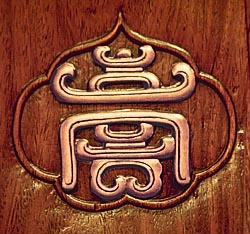 Boxwood is a small tree and shrub. Due to the limited
size of the material, it is rarely used for full-sized pieces of furniture, but
more often for small, carved objects or as decorative inlay. Boxwood is very durable
and dense (.83-.93 g/cm3), and its fine even texture makes it especially suitable
for carving.
Boxwood is a small tree and shrub. Due to the limited
size of the material, it is rarely used for full-sized pieces of furniture, but
more often for small, carved objects or as decorative inlay. Boxwood is very durable
and dense (.83-.93 g/cm3), and its fine even texture makes it especially suitable
for carving.
Numerous varieties, which all produce material of similar
characteristics, are widely distributed throughout China; noted timber varieties
are also harvested in Hubei, Jiangxi, and Sichuan. The tree grows very slowly,
with some varieties reaching only 10-15 cm diameter after 100 years; forests of
Laoshan in Shandong produce boxwood trees with diameters reaching 30 cm.
The sapwood and heartwood of boxwood are indistinguishable, and their freshly
cut pale-yellow color turns to a warm brownish-yellow tone after exposure. The
grain is usually very straight, but can also be irregular. The timber is difficult
to dry and especially prone to splitting. Freshly worked boxwood has an earthy
fragrance. Because of its extremely small vessel cells, the texture is exceptionally
smooth and fine, and the surface polishes to a silky luster.
Burl (Yingmu, Huamu)
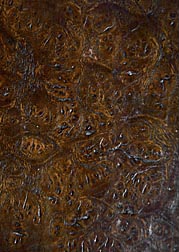 Burls are abnormal projections that bulge out from
or encircle the trunks or branches of trees. What causes them remains unknown
and their tumor-like growth does not appear to adversely affect the tree's health.
Various theories suggest that they result from falling trees, fire or frost damage,
invading fungus or bacteria, or even woodpeckers. Certain species, such as camphor,
elm, nanmu, cypress, and willow also seem to be more susceptible to burl growths.
Burls are abnormal projections that bulge out from
or encircle the trunks or branches of trees. What causes them remains unknown
and their tumor-like growth does not appear to adversely affect the tree's health.
Various theories suggest that they result from falling trees, fire or frost damage,
invading fungus or bacteria, or even woodpeckers. Certain species, such as camphor,
elm, nanmu, cypress, and willow also seem to be more susceptible to burl growths.
The wood tissue of a burl is extremely disoriented and is comprised of many
small bud formations that often appear as clusters of round curls. It is often
difficult to distinguish one burl species from another. However, similar coloring,
texture, and grain patterns of the parent tree can often be detected.
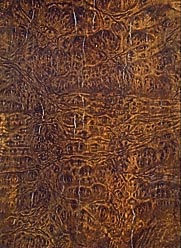 Nanmu burl is often described
as having a "grape seed pattern," which describes the tiny seed-like bud formations
within it. Such burl may also come from the roots of massive nanmu trees.
Wood from the junction of the trunk and roots is full of interesting and distorted
figure caused by the changes in direction of the wood fibers as they branch out
as roots, and by the effects of compression from bearing the weight of the tree.
Nanmu burl is often described
as having a "grape seed pattern," which describes the tiny seed-like bud formations
within it. Such burl may also come from the roots of massive nanmu trees.
Wood from the junction of the trunk and roots is full of interesting and distorted
figure caused by the changes in direction of the wood fibers as they branch out
as roots, and by the effects of compression from bearing the weight of the tree.
Burl-like figure also frequently develops in several varieties of birch (huamu
(Betula)) that grow throughout China. The heartwood is generally light yellow
and sometimes figured with rust-colored 'bird's-eye' or striped patterns. In Chinese,
the term huamu is used interchangeably for birch and birch with burl-like figure,
as well as for burls in general.
Camphor (Xiangzhang)
Cinnamomum
camphora
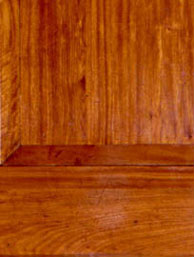 Because of its resistance to insects as well as its
attractive grain patterns, camphor wood has long been used for making wardrobes
and storage chests. Camphor is a large evergreen tree of the laurel family. It
frequently grows to huge proportions approaching 50 meters in height with trunks
reaching 5 meters in diameter. It is widely distributed south of the Yangzi River
including Hainan Island, with the largest concentrations found in Taiwan, followed
by Jiangxi and Fujian.
Because of its resistance to insects as well as its
attractive grain patterns, camphor wood has long been used for making wardrobes
and storage chests. Camphor is a large evergreen tree of the laurel family. It
frequently grows to huge proportions approaching 50 meters in height with trunks
reaching 5 meters in diameter. It is widely distributed south of the Yangzi River
including Hainan Island, with the largest concentrations found in Taiwan, followed
by Jiangxi and Fujian.
The pale sapwood of camphor is clearly distinguished
from the heartwood, whose reddish-brown color is typically figured with darker
reddish striations. The fragrance of camphor is intense after freshly cut, and
its strong scent does not diminish with time. The interlocked grain pattern of
camphor imparts a light and dark striped figure patterned with its open pores
appearing as slanted parallel lines in the radial surface. It is light to medium
in weight (.42-.54 g/cm3) and soft to medium in hardness. It is relatively stable
but not particularly strong as a timber. The texture is even, and the surface
can be polished to a rich luster.
Yellow Camphor (C. parthenoxylon)
also grows throughout southern China, but does not reach the mammoth proportions
of its relative. Although the material is similarly figured, it is lighter in
color, and less dense; and after cutting, its fragrance dissipates with time.
This material is often substituted for the more highly prized variety.
Cypress (Baimu, Bomu)
Cupressus
L.
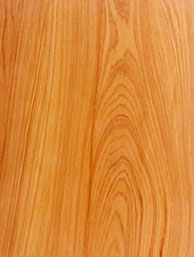 Cypress is categorized along
with nanmu in the Song dynasty Yingzao fashi categorizes as a "miscellaneous
soft wood" (za ruanmu). Late Ming connoisseurs noted the use of Sichuan
cypress as a suitable furniture-making material, and Qing dynasty records from
the Yuanmingyuan also indicate that southern cypress was of comparable value to
nanmu.
Cypress is categorized along
with nanmu in the Song dynasty Yingzao fashi categorizes as a "miscellaneous
soft wood" (za ruanmu). Late Ming connoisseurs noted the use of Sichuan
cypress as a suitable furniture-making material, and Qing dynasty records from
the Yuanmingyuan also indicate that southern cypress was of comparable value to
nanmu.
Of several cypress varieties found in modern China, Weeping
Cypress (C. funebris) is the most highly regarded for its timber. It is
heavily concentrated in Sichuan where it reaches heights of thirty meters and
two meters in diameter. Smaller varieties of lesser quality include Bhutan Cypress,
with concentrations in Gansu, Fujian Cypress, distributed throughout southern
China to the Vietnamese border regions, and Himalayan Cypress (Xizang bai).
The heartwood of Weeping Cypress has a grassy yellowish-brown tonality, and
is sometimes slightly streaked with red. With prolonged exposure, the color becomes
deeper; the sapwood has paler tonalities. The material has good luster, is somewhat
waxy or oily to the touch, and has a pungent fragrance. The grain is generally
quite straight and evenly textured. The weight, density (±.58 g/cm3) and hardness
are both medium to high. Drying is relatively slow, and requires attention to
avoid warpage problems. Afterwards, it is highly resistant to rot and insect damage.
The finely textured material is easy to work and polishes to a bright surface.
Huaimu (Chinese Locust)
Robinia Pseudoacacia
L.
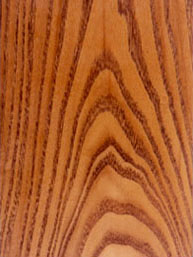 Locust initially appears quite similar to northern
elm. In the Northern Song architecture treatise Yingzao fashi, locust and
elm (yu) were categorized "miscellaneous hardwoods" of similar sawing difficulty.
However, locust is appreciably more dense (.79-.81 g/cm3), and the surface is
more coarsely textured.
Locust initially appears quite similar to northern
elm. In the Northern Song architecture treatise Yingzao fashi, locust and
elm (yu) were categorized "miscellaneous hardwoods" of similar sawing difficulty.
However, locust is appreciably more dense (.79-.81 g/cm3), and the surface is
more coarsely textured.
Locust is distributed throughout China, however
the best is considered to come from northern China. Aside from its noted density,
the timber is hard and very strong. The pores in the early wood can be relatively
large; the grain is relatively straight but unevenly textured. It is relatively
easy to dry, with little warpage; however, it tends to develop large cracks. After
drying, the wood is quite stable and naturally resistant to moisture and insect
damage. It is difficult to cut and to surface; however, afterwards, it reveals
a lustrous surface.
Jumu (Southern Elm, Zelkova)
Zelkova
Schneideriana
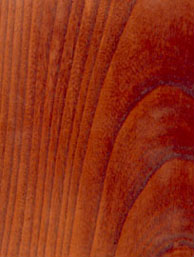 Southern Elm was a popular furniture-making wood in
the Suzhou region. It is distinguished from its northern counterpart by a more
refined ring porous structure that is apparent in the tangential surface, and
by small medullary rays that are visible as fine reflective flecks across the
radial surface. Southern Elm is also comparatively denser and stronger.
Southern Elm was a popular furniture-making wood in
the Suzhou region. It is distinguished from its northern counterpart by a more
refined ring porous structure that is apparent in the tangential surface, and
by small medullary rays that are visible as fine reflective flecks across the
radial surface. Southern Elm is also comparatively denser and stronger.
Southern Elm is widely distributed throughout China with concentrations found
in Jiangsu, Zhejiang, and Anhui provinces as well as Korea and Japan, where it
is commonly known as keyaki. The arbor reaches 30 meters in height and
the trunk, 1.5 meter in diameter.
The sapwood is distinguished from the
slightly darker heartwood, which varies in tonality from yellowish brown to coffee-brown.
Jiangsu craftsmen traditionally divide jumu into three types: yellow ju (huangju),
red ju (hongju), and blood ju (xueju). Factors including the age
of the tree are thought to account for these variations in color as well as ranging
densities (63-.79 g/cm3). Blood ju, with a reddish-brown coffee color as well
as some feathery like figure in the tangential surface, is the most highly prized.
Nanmu
Phoebe nees
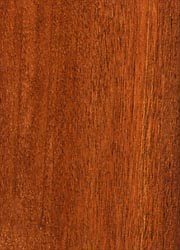 Nanmu and nanmu burl
(douban nan) were frequently mentioned as materials par excellence in Ming
literati writings. The former was often used for cabinet construction; the latter,
for decorative cabinet door and table top panels as well as smaller scholar's
objects.
Nanmu and nanmu burl
(douban nan) were frequently mentioned as materials par excellence in Ming
literati writings. The former was often used for cabinet construction; the latter,
for decorative cabinet door and table top panels as well as smaller scholar's
objects.
Nanmu is a large, slow growing tree of the evergreen
laurel family that develops with a long straight trunk ranging from 10-40 meters
in height, and 50 to 100 cm in diameter. While sharing some characteristics with
the coniferous cedar, it bears no botanical relationship. More than thirty varieties
are found south of the Yangzi River with concentrations in the southwest; varieties
are also indigenous to Hainan Island and Vietnam.
Zhennan (True
Nanmu) from Sichuan and Guizhou, zinan (Purple Nanmu) from the southeastern
and south-central regions, and hongmaoshan nan (Hongmao Mountain Nanmu)
from Hainan Island are generally considered to produce the finest timber. These
wood ranges in color from a warm olive-brown color to a reddish-brown color. Other
species of nanmu with a coarse, loosely structured grain and lighter color
are considered inferior.
Because it is highly resistant to decay, nanmu
was frequently used for architectural woodworking and boat-building. The wood
dries well with minimal warping or splitting after which it is dimensionally stable
and of medium density (zhennan ±.61 g/cm3). Nanmu also emits a pungent
fragrance when freshly worked. And because it polishes to a shimmering surface
and has fine smooth texture, it was also prized as furniture-making wood. Shimmering
characteristics also qualify that which is termed 'jinsi' (golden-thread)
nanmu. The burl of nanmu (douban nan) was also commonly featured
in table and cabinet door
Oak (Zuomu, Gaolimu)
Cyclobalanopsis
(Qingfeng) and Quercus L. (Mali)
 Although furniture made from oak is somewhat rare,
the material has long been known as an excellent furniture-making wood. The variety
known as gaoli was used in the Yongzheng (1723-1735) Imperial workshops,
and earlier examples have also survived. Botanists have identified one hundred
forty types of oaks widely distributed throughout China. These are divided into
the evergreen Qingfeng group and the Mali group, the latter inclusive of both
deciduous and evergreen varieties. Three species suited for furniture-making are
noted below.
Although furniture made from oak is somewhat rare,
the material has long been known as an excellent furniture-making wood. The variety
known as gaoli was used in the Yongzheng (1723-1735) Imperial workshops,
and earlier examples have also survived. Botanists have identified one hundred
forty types of oaks widely distributed throughout China. These are divided into
the evergreen Qingfeng group and the Mali group, the latter inclusive of both
deciduous and evergreen varieties. Three species suited for furniture-making are
noted below.
The Blue Japanese Oak (C. glauca) is widely distributed
from Japan to India and commonly reaches heights of 20 meters with trunk diameters
of one meter. The sapwood and heartwood are not clearly distinguished and range
from grayish-yellow to grayish-brown with streaks of brown or red. The material
is difficult to dry and not easy to work, however, it is extremely dense (±.90
g/cm3) and hard. Distinctive medullary rays appear in the tangential surface as
short dark lines; in the radial surface, they appear as lustrous flecks woven
through the longitudinal grain. The Sawtooth Oak (Q. acutissima) is also
broadly distributed throughout China. With the exception of its reddish-brown
heartwood, other characteristics are similar to the Blue Japanese Oak.
The somewhat less dense (.67-.75 g/cm3) Mongolian Oak (Q. mongolica) grows
throughout north central and northeastern China, and is found from stretching
westward through Japan , Korea, Mongolia, and Siberia. A similar species of growing
in the Xing'anling region of Mongolia has been related to that commonly termed
gaoli mu---Gaoli being a Chinese reference to ancient Korea.
Walnut (Hetao)
Juglans
 Walnut was used for many examples of Qing period furniture
sourced from the Shanxi region, which generally demonstrate refined workmanship;
earlier pieces are extremely rare. Walnut is easily confused with nanmu,
however, the surface of walnut tends to have more of an open-grained texture,
and the color tends more towards golden-brown or reddish-brown when contrasted
with the olive-brown tones of nanmu. Furthermore, their freshly worked
surfaces each emit a distinctive fragrance.
Walnut was used for many examples of Qing period furniture
sourced from the Shanxi region, which generally demonstrate refined workmanship;
earlier pieces are extremely rare. Walnut is easily confused with nanmu,
however, the surface of walnut tends to have more of an open-grained texture,
and the color tends more towards golden-brown or reddish-brown when contrasted
with the olive-brown tones of nanmu. Furthermore, their freshly worked
surfaces each emit a distinctive fragrance.
China has several species
of walnut that produce timber suited for high-quality furniture-making. True Walnut
(J. regia L.) is generally cultivated in the north and northwestern regions,
but also extends into the southwestern provinces. It is a deciduous tree reaching
20 meters in height that produces an edible nut that can be pressed into a high-quality
vegetable oil. The light-colored sapwood is clearly distinguishable from the heartwood,
the latter being reddish-brown too chestnut-brown in color, and sometimes even
purplish, or with darker striated patterning. It dries very slowly, but is quite
stable afterwards. It is of medium density (±.62 g/cm3) and has a relatively fine
texture.
Because True Walnut is generally cultivated for its fruit rather
than timber, Manchurian Walnut (J. mandsharica M.) is often used in its
place. It is distributed throughout the northern to northeastern forests of China.
It is somewhat lower in density (±.53 g/cm3) than True Walnut, and somewhat lighter
in color. Wild Walnut (J. cathayensis) is distributed throughout central-to-eastern
China, with noted concentrations in Yunnan province.
Yumu (Northern Elm)
Ulmus L.
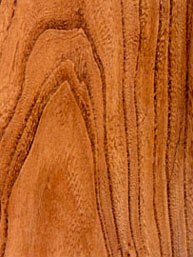 Northern Elm is the most common furniture-making wood
found throughout northern China. It is referred to throughout the catalogue as
Northern Elm to differentiate it from the somewhat similar appearing Zelkova,
which is also commonly called elm, or Southern Elm.
Northern Elm is the most common furniture-making wood
found throughout northern China. It is referred to throughout the catalogue as
Northern Elm to differentiate it from the somewhat similar appearing Zelkova,
which is also commonly called elm, or Southern Elm.
There are over twenty
varieties of elm which are widely distributed tree throughout China, but more
highly concentrated in the northern regions. Northern varieties noted for producing
furniture-making timber include the Japanese Elm (chunyu (U. davidiana var.
japonica)), which reaches 30 meters in height and 1 meter in diameter, and
the somewhat smaller Manchurian Elm (lieye yu (U. laciniata)). These, along
with the more broadly distributed Siberian Elm (bai yu (U. pumila)) all
share similar characteristics.
The sapwood of Northern Elm is yellowish-brown;
the heartwood, a slight chestnut brown. The wood is difficult to dry and easily
develops cracks. The material is of medium density (.59-.64 g/cm3) and hardness,
and with the exception of Siberian elm, has relatively low strength. The material
is somewhat resistant to decay and easy to work. Because the wood is ring porous,
with a wave-like patterning in the growth rings of the late wood, the tangential
surface often reveals a layered, feather-like figure that is popular for furniture-making.
Chinese Elm (lang yu (U. parviflora)) is more concentrated in the
southern tropical regions, but is also found throughout Shaanxi, Shanxi, Hebei.
Its coffee-colored heartwood may also relate to the furniture-making wood popularly
called Purple Elm (ziyu). This timber is also difficult to dry, easy to
warp and split, but considerably denser (±.90 g/cm3) and harder than the other
varieties. It has high structural strength, but the grain patterning is not as
striking as Japanese Elm or Siberian Elm; it is also more difficult to work.
Zhazhen
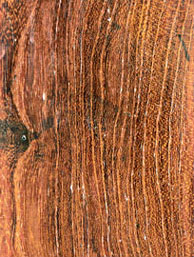 Commonly termed zhazhen or zhajing,
this furniture-making wood is associated with the mulberry species. Furniture
made from zhazhen wood is commonly found in the Subei region of Jiangsu.
The wood is dark reddish-brown and layered with coffee-colored tissue; it has
a fine grain pattern with medullary rays visible in the radial cut. The material
is of medium density, but has low resistance to decay.
Commonly termed zhazhen or zhajing,
this furniture-making wood is associated with the mulberry species. Furniture
made from zhazhen wood is commonly found in the Subei region of Jiangsu.
The wood is dark reddish-brown and layered with coffee-colored tissue; it has
a fine grain pattern with medullary rays visible in the radial cut. The material
is of medium density, but has low resistance to decay.
Hongmu
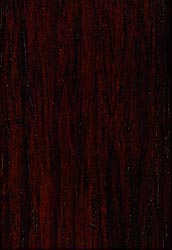 No early references to hongmu
have yet been discovered; however, the equivalent southern Chinese term 'suanzhi'
appears during the middle Qing period—its literal meaning, 'sourwood' describes
the pungent odor emitted when it is worked. Most of the dark heavily carved Qing
period furniture is made from hongmu. Also called 'blackwood', it can resemble
zitan but lacks the latters deep lustrous surface and its 'crab-claw markings'.
There is also a light variety which can be difficult to distinguish from huanghuali.
No early references to hongmu
have yet been discovered; however, the equivalent southern Chinese term 'suanzhi'
appears during the middle Qing period—its literal meaning, 'sourwood' describes
the pungent odor emitted when it is worked. Most of the dark heavily carved Qing
period furniture is made from hongmu. Also called 'blackwood', it can resemble
zitan but lacks the latters deep lustrous surface and its 'crab-claw markings'.
There is also a light variety which can be difficult to distinguish from huanghuali.
Huanghuali
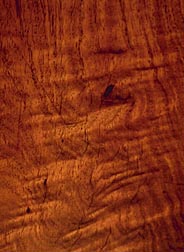 The Chinese term huanghuali
literally means "yellow flowering pear" wood. It is a member of the rosewood family
and is botanically classified as Dalbergia odorifera. In premodern times
the wood was know as huali or hualu. The modifier huang (yellowish-brown)
was added in the early twentieth century to describe old huali wood whose
surfaces had mellowed to a yellowish tone due to long exposure to light. The sweet
fragrance of huali distinguishes it from the similar appearing but pungent-odored
hongmu.
The Chinese term huanghuali
literally means "yellow flowering pear" wood. It is a member of the rosewood family
and is botanically classified as Dalbergia odorifera. In premodern times
the wood was know as huali or hualu. The modifier huang (yellowish-brown)
was added in the early twentieth century to describe old huali wood whose
surfaces had mellowed to a yellowish tone due to long exposure to light. The sweet
fragrance of huali distinguishes it from the similar appearing but pungent-odored
hongmu.
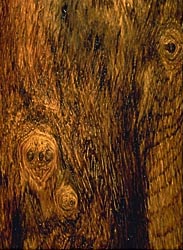 The finest huanghuali has a translucent shimmering
surface with abstractly figured patterns that delight the eye--those appearing
like ghost faces were highly prized. The color can range from reddish-brown to
golden-yellow. Historical references point to Hainan Island as the main source
of huali. However, variations in the color, figure, and density suggest
similar species sourced throughout North Vietnam, Guangxi, Indochina and the other
isles of the South China Sea.
The finest huanghuali has a translucent shimmering
surface with abstractly figured patterns that delight the eye--those appearing
like ghost faces were highly prized. The color can range from reddish-brown to
golden-yellow. Historical references point to Hainan Island as the main source
of huali. However, variations in the color, figure, and density suggest
similar species sourced throughout North Vietnam, Guangxi, Indochina and the other
isles of the South China Sea.
Jichimu
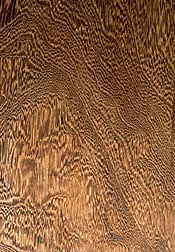 Jichimu, literally translated
as 'chicken-wing wood', describes a wood whose deep brown and gray patterns when
cut tangentially resemble the patterns of bird feathers. The radial cut appears
less dramatically with parallel lines of concentric layered tissue. It is botanically
classified in the Ormosia genus of which as many as twenty-six species
may grow in China. Jichimu is indigenous to Hainan Island, and the relatively
large quantity of jichimu furniture found in Fujian province also corresponds
to a source where seven different species are reportedly found today, and whose
materials are virtually undifferentiated, yet bear varying leaf patterns. Hongdou
(red bean), and xiangsi may also be other names for related species.
Jichimu, literally translated
as 'chicken-wing wood', describes a wood whose deep brown and gray patterns when
cut tangentially resemble the patterns of bird feathers. The radial cut appears
less dramatically with parallel lines of concentric layered tissue. It is botanically
classified in the Ormosia genus of which as many as twenty-six species
may grow in China. Jichimu is indigenous to Hainan Island, and the relatively
large quantity of jichimu furniture found in Fujian province also corresponds
to a source where seven different species are reportedly found today, and whose
materials are virtually undifferentiated, yet bear varying leaf patterns. Hongdou
(red bean), and xiangsi may also be other names for related species.
Tieli wood
 Tieli wood is often confused with jichimu,
yet lacks the latter's contrasting colors. Tieli is predominantly grayish
black, and its open grain has a coarse texture. It once grew abundant in Guangdong
where its large timbers were used for bridges and house construction; on Hainan
Island the natives used it for firewood. Nevertheless, in the more northern regions
its was regarded as a rare hardwood and was noted for as a desirable wood for
furniture-making in late Ming texts. Furniture made from tieli often has
a thick quality and is frequently with little or no carved decoration.
Tieli wood is often confused with jichimu,
yet lacks the latter's contrasting colors. Tieli is predominantly grayish
black, and its open grain has a coarse texture. It once grew abundant in Guangdong
where its large timbers were used for bridges and house construction; on Hainan
Island the natives used it for firewood. Nevertheless, in the more northern regions
its was regarded as a rare hardwood and was noted for as a desirable wood for
furniture-making in late Ming texts. Furniture made from tieli often has
a thick quality and is frequently with little or no carved decoration.
Ebony (Wumu)
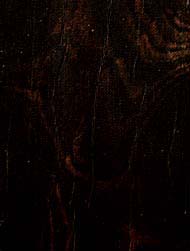 Wumu, or ebony, is botanically related to the
Ebenacea family. It has a fine closed grain which is very brittle, and
the color can be pure black to black and brown. Because it grows as a small-diameter
tree, it is rarely used as primary material for large pieces of furniture, but
more often shaped into secondary decorative elements or as small precious objects.
Wumu, or ebony, is botanically related to the
Ebenacea family. It has a fine closed grain which is very brittle, and
the color can be pure black to black and brown. Because it grows as a small-diameter
tree, it is rarely used as primary material for large pieces of furniture, but
more often shaped into secondary decorative elements or as small precious objects.
Zitan
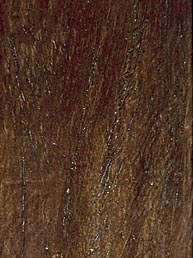 Zitan is an extremely dense wood which sinks in water.
It is a member of the rosewood family and is botanically classified in the Pterocarpus
genus. The wood is blackish-purple to blackish-red in color, and its fibers are
laden with deep red pigments which have been used for dye since ancient times.
The fine texture of the wood grain is especially suitable for intricate carving.
Zitan is an extremely dense wood which sinks in water.
It is a member of the rosewood family and is botanically classified in the Pterocarpus
genus. The wood is blackish-purple to blackish-red in color, and its fibers are
laden with deep red pigments which have been used for dye since ancient times.
The fine texture of the wood grain is especially suitable for intricate carving.
Early records indicate that zitan was sourced in tropical forests of southern China, throughout Indochina, and from Hainan Island. The tree grows quite slowly. Few pieces are known to be greater than one foot in width. While the tree has been considered to be extinct, new sources have been discovered in Indo-China as well as Southeast Asia over the recent years.
Decorative Stone
 Decorative stone was used as a secondary material
for table top panels, decorative inlay panels, and impressionistic screen panels.
The natural imagery revealed in a slice of geological time often revealed abstract
landscape scenes or figures.
Decorative stone was used as a secondary material
for table top panels, decorative inlay panels, and impressionistic screen panels.
The natural imagery revealed in a slice of geological time often revealed abstract
landscape scenes or figures.
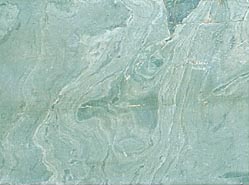 Soft decorative stone such as marble or serpentine
were commonly used; agate panels were also used, but much more rarely.
Soft decorative stone such as marble or serpentine
were commonly used; agate panels were also used, but much more rarely.
Paktong
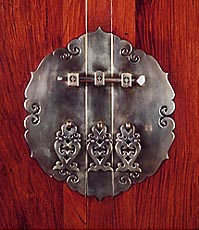 Paktong, or baitong hardware was commonly used
for reinforcement and decoration. Paktong is essentially a brass alloy with a
5-10% nickel content with imparts a silvery luster and retards the tarnishing
which is typical to brass. Metalsmiths were a specialized trade distict from woodworking
carpenters.
Paktong, or baitong hardware was commonly used
for reinforcement and decoration. Paktong is essentially a brass alloy with a
5-10% nickel content with imparts a silvery luster and retards the tarnishing
which is typical to brass. Metalsmiths were a specialized trade distict from woodworking
carpenters.
Woven Cane
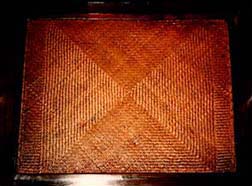 Soft, woven seats were traditional to Ming and early
Qing furniture, although the use of hard seat panels is occasionally noted in
early examples. Aside from its pliable support, the airiness of the woven bed
frame was especially comfortable during the hot summer seasons. With regard to
chairs, the customary use of woven seats gives way to increasing use of hard-panel
seats during the 18th and 19th centuries, and old soft seats were also occasionally
replaced with maintenance-free hard panels during this period.
Soft, woven seats were traditional to Ming and early
Qing furniture, although the use of hard seat panels is occasionally noted in
early examples. Aside from its pliable support, the airiness of the woven bed
frame was especially comfortable during the hot summer seasons. With regard to
chairs, the customary use of woven seats gives way to increasing use of hard-panel
seats during the 18th and 19th centuries, and old soft seats were also occasionally
replaced with maintenance-free hard panels during this period.
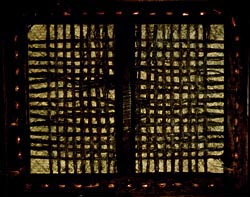 Seat weaving was a specialized tradition, and itinerant
specialists facilitated their frequent repair and renewal. Soft seats were produced
in several traditional styles. Occasionally, processed animal tendons were used
to weave an extremely pliant matting. Woven-rope and leather-strip seats were
common to folding stools and folding chairs. More commonly, an underwebbing of
twisted palm fiber was woven through the holes in the seat frame, after which,
split cane was woven directly on top.
Seat weaving was a specialized tradition, and itinerant
specialists facilitated their frequent repair and renewal. Soft seats were produced
in several traditional styles. Occasionally, processed animal tendons were used
to weave an extremely pliant matting. Woven-rope and leather-strip seats were
common to folding stools and folding chairs. More commonly, an underwebbing of
twisted palm fiber was woven through the holes in the seat frame, after which,
split cane was woven directly on top.
The craft of weaving cane has all
but disappeared. Modern recaning continues the underwebbing technique, however,
the finely woven mat has been replaced by sheet matting that is cut to size and
simply pinned into the holes with softwood wedges. The fiber and cane, having
been soaked for several hours before weaving, dries to a taught, yet elastic seat
panel.
- - - - - - - - -
Material
Timber and lacquer are the most widely used materials in furniture, with the lacquering technique or process having a significant affect on the value of a piece. Other materials used are stone, marble, shell, coral, pearl, ivory, bone, gold leaf or various metals. Again, all other things being equal, the harder the timber, the higher the value of the furniture (for instance, huanghuali is regarded as the hardest and most expensive timber, while pine is the softest and least expensive).
Timber
can be classified into six categories. In descending order of hardness (and value),
they are:
1. huanghuali (yellow rosewood), zitan (sandalwood), jichimu (Chicken
Wing wood)
2. hong-mu (blackwood), tielimu (ironwood), jarjingmu, wu-mu (ebony),
ying-mu (burl), hua-mu (gingko)
3. ju-mu (southern elm wood), hetaomu (walnut
wood), huang-yang mu (box wood), lung-yan mu (tiger-skin wood), zuo-mu (Oak)
4.
nan-mu, kundianmu, shizimu (persimmon)
5. yu-mu (elm), zhang-mu (camphor),
hualimu (rosewood), huai-mu (Locust), tao-mu (peach), li-mu (Pear)
6. pai-mu,
song-mu (pine), shang-mu (cedat), qiu-mu (Catalpa), duan-mu (poplar), Bai-yang
mu (paulownia), wu-tong (Kiri)
http://www.chinese-classical-furniture.com/chinese-furniture-buy.html
--------------------------------------------------------------------------------
Taking Care Of Chinese antique furniture
Every piece of furniture has been carefully selected by EJ Grant Antiques for your use and enjoyment. Most of the furniture is over 100 years old.
Wood is an organic substance and each species has its own characteristics in terms of color, grain, texture and smell. The first step in the care of your furniture is to understand the conditions that can cause damage. The second step is to follow some basic guidelines for care, handling and cleaning.
Causes of Damage
Handling
The
primary cause of damage to furniture is careless handling. Furniture, no matter
what size, should always be moved by grasping the sturdiest part (for example,
chairs should be lifted by the seat and table by the rail.) Items should never
be dragged as this will place stress on their legs, feet and arms.
Furniture
surfaces must always be protected from alcohol and water (drink coasters, for
instance.) If water or alcohol does come in contact with the finish, it should
be removed immediately. This is particularly important if you have a shellac based
finish. If tables are protected by glass tops, felt or plastic tabs should be
used so that the glass does not stick to the furniture finish.
Environment
All
wood finishes are subject to change when exposed to light Depending on the type
of finish and wood, this can range from darkening to fading. If objects are left
in the same position on a piece of furniture for a long period of time, uneven
facing will occur. Where possible, direct sunlight should be avoided as the heat
generated may cause damage by softening or cracking the finish.
Temperature
and Humidity
Wood is a porous material and absorbs water when humidity levels
are high. This causes the wood to swell. Conversely, wood shrinks in a dry environment.
This causes movement within the structure of the wood and can produce cracks,
veneer lifting and gaps in joints. Rapid fluctuations in humidity and temperature
cause the greatest amount of damage. Furniture can withstand considerable variation
in temperature and humidity provided the change occurs at a slow rate. Remember,
houses prior to the 20th century did not have air conditioning and central heating
and by and large the furniture survived quite well. The main damage was generally
done to the feet.
In an ideal world, the recommended temperature and humidity levels should be:
Temperature Relative humidity
Winter 70° F 35 - 45%
Summer 70° - 75°/font>
F 55 - 65%
Cleaning
Contrary
to common belief you do not have to "feed" the wood, and the following
information will assist you to keep your furniture in prime condition.
Do
not use a polish containing silicone. Just dust with a soft dry cloth.
Once
or twice a year you may wish to wax the furniture with a good polish containing
beeswax and carnauba wax. Apply sparingly, and buff with a soft cloth.
Do
not use kitchen cleaners as they may scratch the finish.
Do not use chemical
cleaners, Pledge?or other commercial cleaners.
Conclusion
If you follow the above guidelines your furniture will give you pleasure for a very long time. However, furniture can become damaged. In such a case, you should approach a furniture restorer/conservator who is experienced in restoring furniture similar to what you have. A list of conservators can be obtained from the American Institute of Conservation or from the Washington Conservation Guild (In the Washington, DC area.)
Maintenance
Tips
Taking good care of your furniture will enhance its practicality as well
as its value. Central to this is understanding how a piece is constructed and
decorated, and—if it is made of wood—how this natural material reacts
to its environment. Appropriate use, swift repair in response to accidental damage,
and the right environmental conditions should ensure that your furniture remains
in good condition.
Cleaning
Furniture
generally requires a minimum of cleaning. A weekly light dusting together with
a twice-yearly wax polishing—if the piece is made of wood—should suffice.
Particular care should be taken with inlays, marquetry and veneers, in case your
polishing cloth lifts a piece. If this does happen, keep the broken piece and
contact a restorer. Lacquer is also vulnerable to excessive handling. Gilded fittings
should not be cleaned since the gilt may easily be removed.
Moving
The
definition of the word "furniture" is a "moveable article to equip
a room or a house"—its portability is central to its function. Considerable
care should therefore be taken when handling furniture. At least two people should
lift larger pieces, balancing the load and supporting the main carcass or frame
rather than grasping chair backs or tabletops, for example. Never drag an item
of furniture; even pieces with castors should be lifted when possible since legs
can be easily broken. Drawers and other detachable elements can be removed to
lighten the load, and doors should be tied shut.
Positioning
Wood
is particularly susceptible to the effects of light and heat. Direct sunlight
causes wood to fade and lose its color; heat warps and shrinks wood, causing veneers
to lift from the carcass. Always keep pieces away from fireplaces and radiators.
If it is impossible to avoid direct sunlight, use a protective cover on the furniture,
a thick blind on the window, or apply ultraviolet-absorbent filters to windowpanes,
which will prevent these damaging rays from entering the room.
In addition, antique furniture is sensitive to humidity. The ideal room climate is 64°F (18°C) and 50% humidity, with a 20% variation. Humidifiers are available at hardware stores and will help to maintain and monitor humidity levels.
Should your furniture suffer shrinkage or splitting, it is essential that you adjust the environmental conditions before repairs are carried out. Otherwise, further splitting may occur.
Restoration
It
is natural that the enjoyment and use of antique furniture might lead to accidental
damage, such as stains, loose joints, or broken inlays and veneers. Should this
occur, consult a reputable furniture restorer.
Wood
is a natural living product, therefore, wood furniture will "breathe"
in response to changes in the atmosphere. Rapid or extreme fluctuation in temperature,
humidity or direct sunlight may cause cracking, splitting, and/or warping of the
piece. The ideal condition for furniture is a stable atmosphere with fluctuations
ranging between: a relative humidity of 40 - 70% ; a temperature of 15 - 25 degree
(Centigrade) . Operating a humidifier or placing a glass of water inside or underneath
the furniture will help to maintain the right level of humidity. Wood as a plant
contains water in its structure. Throughout our manufacturing process, substantial
amount of water would have been eliminated from the wood to make it stable. However,
wood still expands or contracts as related to the relative humidity in the air.
One exception is wood that has undergone chemical treatment.
The design of
Chinese furniture has already catered to this behavior of wood. In particular,
a large surface is usually made with floating panel framed by wood members on
four sides. The floating panel can expand or contract but still has its surface
secure and intact. In an extremely dry environment, the contraction, however,
might reveal certain "un-colored" portion of the tongue that is inserted
into the wood members. If the furniture is moved to a higher humidity environment,
the wood will expand and the "un-colored" portion will be concealed
again. This is a normal behavior for Chinese furniture.
The ideal condition
for furniture is a stable atmosphere with relative humidity fluctuations of 40
- 70 percent, and a temperature from 60 - 80 degrees Fahrenheit. Operating a humidifier
or putting a glass of water inside or underneath the furniture may help to maintain
humidity.
Strong sunlight can cause fading or other changes. If you leave
objects in a permanent position on the furniture, uneven fading may also occur.Avoid
placing furniture next to radiators, hot air vents, air conditioners, or open
windows. Do not place hot containers directly onto the surface of the furniture.
Careless handling of the furniture may also cause damage.
Wood is an organic
substance, and each species of wood has individual characteristics such as color,
texture, and smell. We apply appropriate finishes on each piece with those characteristics
in mind, so the finish and the design of the wood enhance one another and work
together harmoniously.
Use dry cloth, soft brush or the brush of a vacuum
cleaner to remove dust on the furniture. If needed, use a dry or mild damp cloth
to wipe away dirt or stains. This is the only cleaning you need for the furniture.
Never use too much water to clean the furniture.
There is normally no need
to re-wax the furniture very offen . Just wiping with a dry cloth can restore
the shimmer. However, if there has been too much stain on the surface, or the
furniture has lost its shimmer altogether, re-wax is then needed. Use only a thin
layer of soft "paste like" furniture wax. High quality furniture beeswax
is easily available in the market. Never use the spray type furniture wax, otherwise
you will have to say good-bye to the beautiful furniture color.
For certain
finish of our pieces , the paint and color is made very thin to best reveal the
wood grains. The furniture surfaces therefore cannot withstand too much scratching.
So if objects such as lamps or vases are to be placed on furniture top, it is
highly recommended to shield them with soft padding on their bottom surfaces.
Do not use abrasive kitchen cleaners, as they will scratch the surface.
Do
not use chemicals or other commercial cleaners on furniture.
http://www.chinese-classical-furniture.com/chinese-furniture-care.html